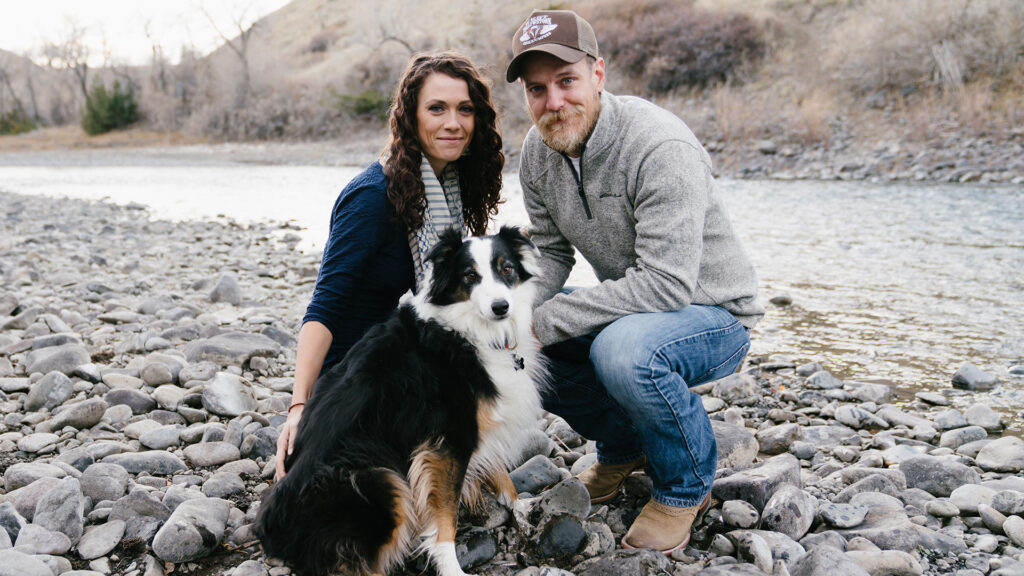“Unfortunately, that fear became a reality…”

Last week, I wrote about the accident that killed Tim Hart, one of the smokejumpers sent to fight the Eicks Fire on private land in Hidalgo County in 2021. This week, I’d like to highlight his widow, Michelle Hart, who spoke with me about Tim and about the challenges wildland firefighters and their families face.
“It was extremely hard for me, having my partner be gone for six, seven months out of the year; gone on assignment, not being able to talk to them sometimes for weeks on end, and constantly living in fear that something is going to happen,” Michelle said. “And unfortunately, that fear became a reality for me and for the people who loved [Tim].”
Wildland firefighters face disasters and emergencies; they get hurt and sometimes, see their colleagues and friends die. For months at a time, they work physically grueling jobs with little rest while being exposed to smoke and other hazards. They’re away from their families and homes and oftentimes, struggling to pay their bills or access health care. Then, Michelle explained, they come home and must “recalibrate” to family life. It’s not easy for anyone.
During our conversation, I noted some of the statistics about wildland firefighters — high rates of trauma, alcohol abuse, mental health challenges, and PTSD — and she wasn’t at all surprised.
“Certainly, if you know a wildland firefighter, please ask them how they’re doing, especially in their time off because I guarantee that they have seen some things and have been through a lot,” she said. “And I’m sure they could use somebody to talk to.”
I’m always thankful to anyone who appears on the show, but especially to someone like Michelle, who could have ignored my email or declined to talk about her loss and the many challenges she’s faced — since Tim’s death and even before then. You can watch the full interview here.
And, if you want a glimpse into what it’s like to work a desert fire, check out The Hotshot Wake Up post, “Desert Fires. Infernos or Ashtrays.”
In the news:
• “Councilor Dan Lewis ‘likely violated’ ethics law during air quality board controversy” (Elizabeth McCall and Elise Kaplan, City Desk ABQ)
• “The Other Border Dispute Is Over an 80-Year-Old Water Treaty” (Martha Pskowski, Inside Climate News)
• “Sens. Heinrich, Luján fund hydrogen safety study” (Geoffrey Plant, Taos News)
• “Texas Has ‘the Most Aggressive’ Well-Plugging Program in the U.S. So Why Is Its To-Do List So Long?” (Elliott Woods, Capital & Main)
• “What if the future is the past?” (Ruxandra Guidi, High Country News)
• “As the Gila Wilderness turns 100, the Wilderness Act is still a living law” (Marissa Ortega-Welch, High Country News)
• “A Climate Scientist Is Voted President of an Oil Country. Now What?” (Somini Sengupta, The New York Times)
• “Vermont Moves to Hold Fossil-Fuel Companies Liable for Climate-Change Damage” (Elizabeth Kolbert, The New Yorker)
• “Images of Climate Change That Cannot Be Missed” (Bill McKibben, The New Yorker)
• “As Insurers Around the U.S. Bleed Cash From Climate Shocks, Homeowners Lose” (Christopher Flavelle and Mira Rojanasakul, The New York Times)
• “Climate Change Added a Month’s Worth of Extra-Hot Days in Past Year” (Raymond Zhong, The New York Times)
• “‘Heat dome’ brings California’s first heat wave of the season, with triple-digit temperatures” (Grace Toohey, Los Angeles Times)
I’m sure you’re all feeling the heat, too.
It felt like summer roared into Albuquerque last week; I wasn’t quite prepared for the hotter days (and nights). The trees and other plants in my yard need more water; I even noticed birds panting. And of course, I’m hot and sweaty and grouchy.
But like many of you, I’m one of the lucky ones. I can close my window blinds during the day, open the windows at night. I work indoors, in a building that has cooling. I have safe places to cool off and recharge and escape the sun and heat.
Not everyone does. And driving down Coors Boulevard on Saturday during the heat of the day, I witnessed even more people than usual struggling to get through their days as they waited at bus stops, walked, or tried to rest in places utterly devoid of shade, never mind water or cool air.
Although we aired the show back in February, I wanted to mention an interview with Dr. Joanna Katzman, who directs Project ECHO’s Public Health Initiatives. She spoke with me earlier this year about the ways health care workers can recognize how climate change (and heat waves, for example) affect patients.
“People who live in urban areas are more affected by extreme heat and so if you’re working in these cities or if you’re homeless or if you’re a vulnerable patient — someone who might have a substance use disorder or if you don’t have air conditioning or if you’re impoverished — you might be much more susceptible to extreme heat,” Katzman said during our conversation.
“When we have these long days and weeks of hot temperatures, it would be really nice if New Mexico could put out more public service announcements about prolonged heat waves, and prolonged impacts. Many patients who have depression, who have psychotic disorders like schizophrenia, are on dopaminergic medications that, along with extreme heat, there are interactions that can adversely affect the patient,” she said.
If you’d like to learn more from Katzman, you can watch that show online.
P.S. If a friend forwarded you this message, sign up here to receive the newsletter yourself. You can also read recent newsletters online. And if you miss us throughout the week, follow Our Land on Instagram.


